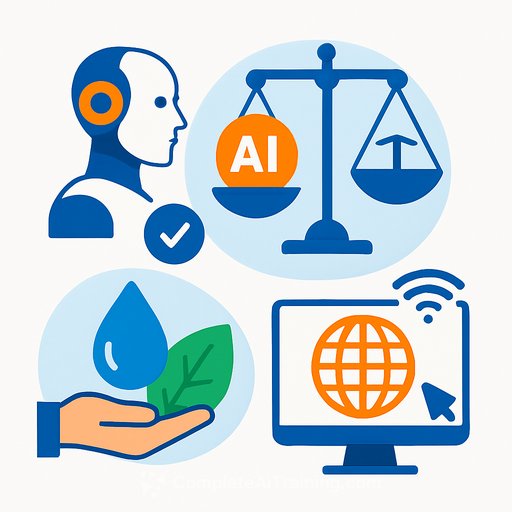Microsoft's new security agents: how to stay a step ahead of AI-enabled attackers
Attackers are starting to use AI agents to probe, phish, and move faster than human teams can respond. Microsoft's latest Security Copilot agents push back by automating the boring work, flagging what matters, and embedding help directly into the tools your teams already use.
For managers, this isn't a future bet. It's an immediate way to reduce noise, speed up response, and prevent incidents before they spread.
- New and enhanced AI security agents arrived at Microsoft Ignite.
- They're embedded in Defender, Entra, Intune, and Purview-right where your teams work.
- Included at no extra cost for Security Copilot customers with Microsoft 365 E5.
AI changes the security game
Security has always been a back-and-forth: defenders close one door, attackers test the next one. Now, threat actors are starting to use AI agents to execute attacks at scale-scanning, testing, and adapting with little human oversight. That velocity turns small cracks into real incidents.
Enter Microsoft's push: a growing set of AI agents that automate triage, highlight emerging risks, and recommend targeted fixes before the mess spreads. It's less "more dashboards," more "fewer alerts you can trust."
Microsoft Security Blog has been signaling this shift for months-AI embedded where work happens, not bolted on after the fact.
Where you'll see the agents (and what they do)
Microsoft is standardizing how agents show up across its security stack. That matters for adoption. Your SecOps, identity, device, and compliance teams will see agent capabilities inside the tools they already use:
- Microsoft Defender (SecOps): Agents help triage incidents, surface threat intel, recommend actions, and link directly to the affected assets.
- Microsoft Entra (Identity): Agents monitor sign-ins and policy behavior, spot bad patterns, and suggest fixes before users feel the pain.
- Microsoft Intune (Endpoints): Agents watch device posture and configuration drift, keeping endpoints compliant with less manual chasing.
- Microsoft Purview (Compliance): Agents support governance and data protection workflows with context-aware recommendations.
Notable agents announced or improved
- Phishing Triage Agent (Defender): Now generally available. It processes user-reported phish at scale, auto-resolves false positives, and escalates only the cases that truly need human eyes.
- Threat Intelligence Briefing Agent (Defender): Pulls briefings from multiple intel sources, scores risk, recommends next steps, and links to the exact systems and identities you need to secure.
- Copilot Conditional Access Optimization Agent (Entra): Monitors sign-in failures and policy impact across devices and identities, investigates the likely cause, and proposes precise changes to fix the issue-before it hits more users.
Microsoft is also treating agent identities as first-class identities in Entra. That means you should govern AI agents with the same rigor as human accounts: assign least privilege, log activity, and review access regularly. The OpenID Foundation and others have been advocating this approach.
How you'll deploy them
Agents will be discoverable through in-product storefronts tied to each portal (all backed by a central Microsoft security store previewed on September 30). In Defender, for example, you'll see agents like Phishing Triage available right in the operations view.
Microsoft's own agents are joined by partner-built agents, giving you a growing menu of automations that fit your stack and policies.
Licensing and timing
If your organization has Security Copilot with Microsoft 365 E5, Microsoft's agents are included at no additional charge. For organizations without Copilot, Microsoft says availability will expand and you'll receive a 30-day notice before activation options open up.
What leaders should do now
- Assign ownership by portal: Defender (SecOps), Entra (Identity), Intune (Devices), Purview (Compliance). Make someone accountable for agent rollout and tuning in each area.
- Start in a pilot tenant: Turn on preview agents, define escalation rules, and document handoffs between AI and analysts.
- Update identity governance: Treat agent identities like people: least privilege, just-in-time access, and auditable logs.
- Route user-reported phish to automation: Let the Phishing Triage Agent clear the noise so analysts focus on real threats.
- Track impact with simple KPIs: Mean time to triage, policy-related sign-in failures, false-positive rate, and percentage of auto-resolved alerts.
- Upskill your team: Teach analysts to review agent recommendations, write clear follow-up prompts, and standardize acceptance criteria.
Bottom line
Attackers will use AI agents to move faster. Your best response is to do the same-inside the systems your teams already live in, with controls that fit your governance model. These Microsoft agents won't replace analysts; they'll clear the noise, close gaps earlier, and let your experts focus where their judgment matters.
If you're building a training plan for managers and SecOps leads, consider targeted upskilling in AI-assisted operations. See AI training by job role for practical options.
Your membership also unlocks:






